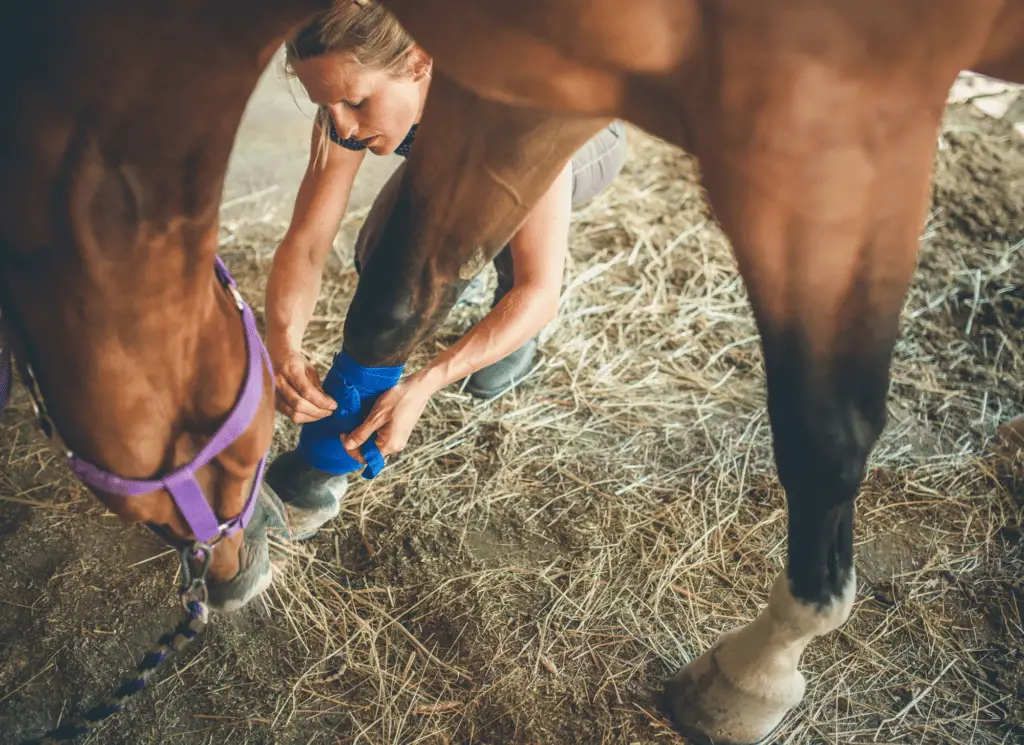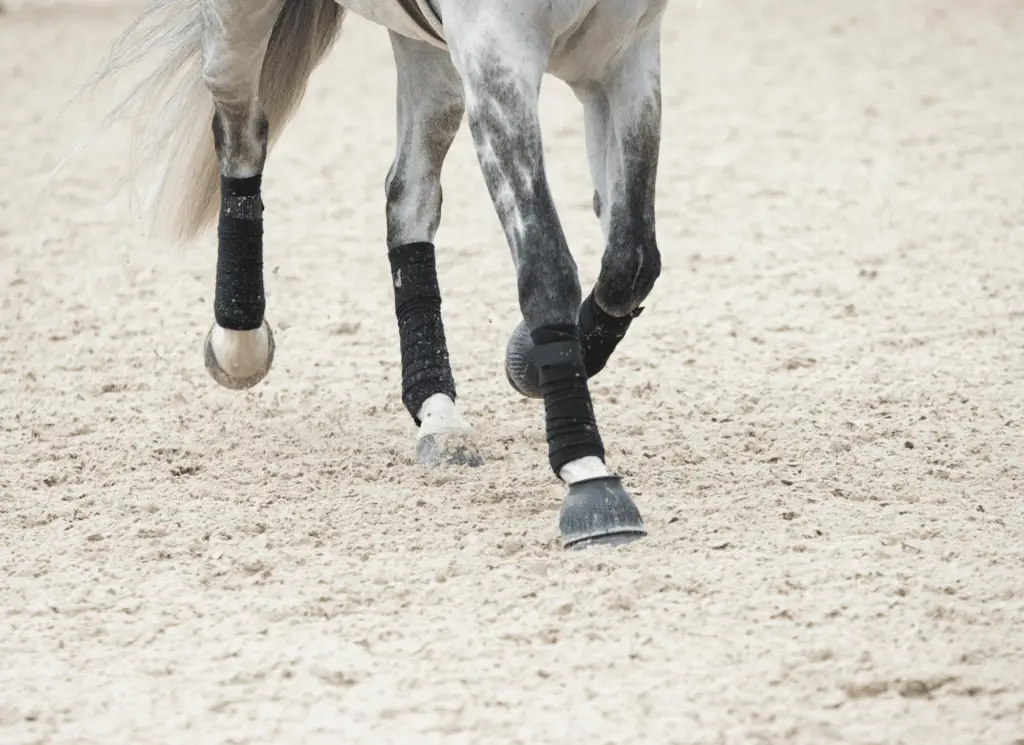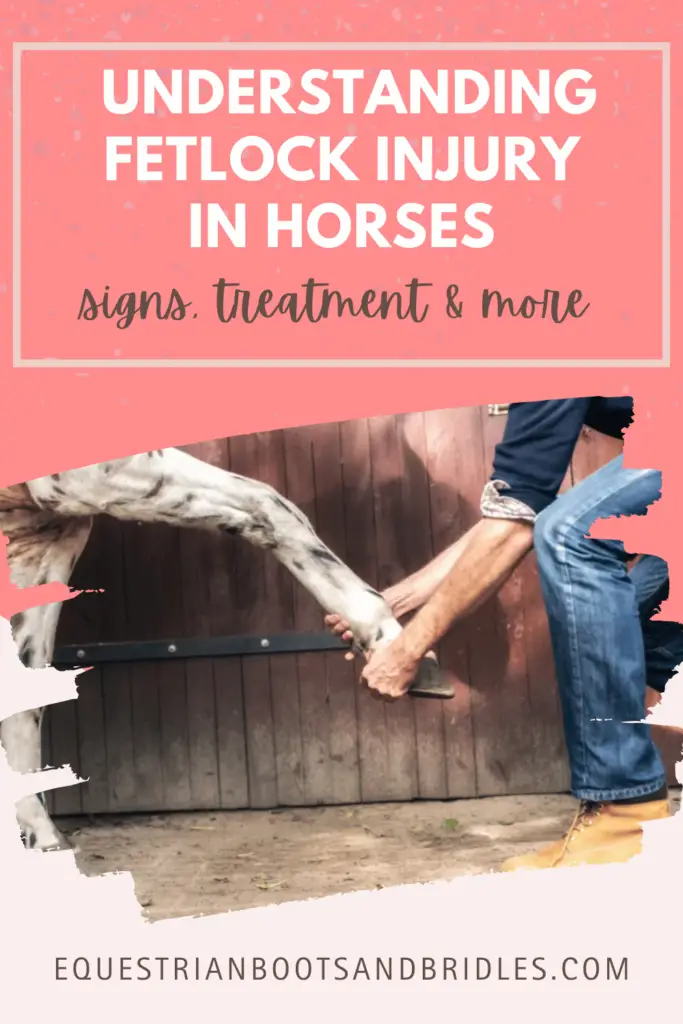The fetlock joint in horses is an area where injuries often occur, and it’s a sensitive and complex part that can suffer extensive damage due to injuries and over-bending.
In this guide, you’ll learn about what causes fetlock injuries in horses, different ways you can asses your horse (or one you’re buying) to see if they may be suffering from fetlock lameness, how fetlock injury is usually treated, and more.
First let’s make sure you know what the fetlock is. If the horse’s pastern is their ankle, then the fetlock is the section just before the ankle. For you, the fetlock would be the bony section before your wrist and hand.

What Is the Fetlock Lameness in Horses?
Firstly, the fetlock is an important part of the horse’s leg, and with the pastern and knee, it aids in providing flexibility and bend to the horse’s leg. When this part becomes damaged, either through injury, excessive wear and tear, or conformational flaws, it seriously compromises the horse’s mobility and comfort.
Fetlock lameness is when the fetlock becomes damaged to the point that the horse’s ability to move fluidly is affected. They start to step shorter on the injured side or walk with stiff legs due to an inability to provide correct flexion in their fetlock.
Horse riders, no matter the riding discipline they perform or participate in, should take notice of fetlock lameness as it is a painful condition for the horse that, if left untreated, can become a permanent and degenerative condition. For the advanced level performance horse such as those performing in dressage or Western games, even slight fetlock lameness can seriously affect their ability to perform well.
11 Signs of Fetlock Lameness in Horses
Fetlock lameness can be hard to diagnose effectively. Horses instinctively hide any difficulties with movement as lame horses are usually hunted by wild predators in the wild. Movement is life.
When evaluating your horse for lameness in the lower leg, it’s important to take a holistic approach. Start with the horse on the walk in a straight line, then on a circle. Finally, if the horse is able to trot, trot them straight and then on the circle. Do the circle to the left and to the right.
Look for the following signs:
- Stepping short on one side
- Stepping to the outside more than the other side with one leg
- Dropping of the hip when the leg goes forward
- Increased speed of step on either side (often visible as a little hop)
- Head nodding
- Carrying the head slightly to the side to balance out the lame side
- Misalignment of the spine
- Poor muscle tone on one side
- Heat
- Swelling
- Sensitivity when flexing the joint by hand
When a vet is contacted for a visual assessment, they will usually perform flexion tests, where one leg is flexed with the fetlock hyperflexed for a few seconds, before encouraging the horse to trot on as soon as the leg is released. Severe lameness that lasts more than a step or two is indicative of fetlock lameness and injury—but it doesn’t show where exactly the fetlock is injured or whether there is involvement of the pastern joint.
For a more advanced assessment and to facilitate advanced treatment, nerve blocks are given. Essentially, the horse’s leg that is suspected of lameness is injected with anesthesia from the pastern upward. The horse is then ridden after each injection to assess whether that particular injection has numbed the pain or if there’s still lameness. If the horse is still lame or shows signs of unsound movement, the next injection is given slightly higher up in the fetlock.
It’s a highly accurate but painful and tedious task to find the exact point of pain or injury, and it is also costly.
Other Methods of Assessment
If you suspect injury to the fetlock, your vet can start with a radiograph or X-ray of the fetlock. The X-ray may not show ligament injuries unless severe, but it can show degenerative joint disease, bone spurs, and more. If there are bony outgrowths, the horse may require surgery to remove these and restore the full range of motion.
Infrared scanning can also assist in a definitive diagnosis as heat spots can help narrow down the areas where injuries have produced inflammation. The vet may then inject hyaluronic acid into the joint capsule, assisting with rebuilding joint cartilage that has been worn away.

Causes of Fetlock Lameness
The fetlock joint is a complicated high-motion joint made of delicate cartilage, soft tissue structures, and ligaments that make up a suspensive mechanism. This delicate combination of parts is vulnerable to injury, infection, and strain.
Let’s look at a few of the causes of fetlock lameness in horses.
- Impact and Shock
When the horse is worked over a hard surface such as rocky ground or a road, their joints have to cushion more vibrational forces. Over time, these forces will cause either bone malformation or degeneration of the soft tissue structures and ligaments.
The result of this kind of work is often joint capsule fibrosis, where the capsule hardens or calcifies. Flexibility is reduced and inflammation results from the mechanism no longer working efficiently.
- Overbending
The fetlock joint is complex with many moving parts. The joint can take an amazing amount of force when carrying the horse’s weight into and out of a step. When the joint becomes hyper-flexed or over-bent, the ligaments can take strain, even tearing. The ligaments will begin to thicken and solidify when small tears happen frequently, reducing their ability to flex.
Excessive overbending can also create small tears in the tendon sheath of the suspensory ligament, causing synovial fluid to ooze out, reducing the ligament’s overall health.
- Infection
The horse’s fetlock is prone to infection when they suffer typical injuries like wire cuts, small punctures, and lacerations from fences or wires. The infection may seem to clear up easily, but lasting damage can happen when the infection and resulting inflammation increase the temperature in the fetlock capsule. If left untreated for too long, a poor prognosis is likely.
- High Impact Work
While horses are born athletes, they can also suffer degenerative injuries due to extreme maneuvers. In Western games, for example, one extreme movement is the sliding stop, and with showjumping, the jumping horses have to increase the amount of lift in their joints while also landing with increased force to clear high fences.
- Repeated Trauma
Horses that are exposed to the same kind of trauma, such as knocking a pole on a jump fence or continually being asked to perform high-impact maneuvers, can suffer from fetlock lameness. Young horses are also more susceptible to injuries from intense work such as fetlock fracture as their joints are still in the process of development.
Putting boots on your horse when doing certain activities (like jumping) can help prevent this.

Assessment of Fetlocks for the “For Sale Horse”
Sadly, not all horse owners are responsible or willing to take the time to rest a fetlock joint that is injured, and often a good horse gets sold on instead of receiving the treatment they need. When viewing a new horse for purchase, it’s important to assess the health of the horse’s joints, especially their knees and fetlocks.
While you can have the horse vet-checked, this may not always be an option for you. So you can perform a few quick tests to check whether the horse is sound or has some joint issues. Start with:
- A trot on a straight line in hand.
Look for straightness, uniform muscle movement, shortness of step, timing of step, and head nodding.
- A trot on a circle to the left and to the right.
Consider the same as above, but also keep an eye for a shoulder being dropped to the inside or hauled over to the outside. Legs swinging out of the circle are also an indication of joint issues.
- Ridden tests.
If possible, ride the horse, feeling the smoothness of their stride. You can easily tell this by closing your eyes and feeling the motion of your hips—are they moving evenly or is one hip tilting more than the other?
- Listen to the horse.
Horse joints often speak to us, if we listen. You may hear the slightest click or clack when the horse moves their legs forward or backward. A joint isn’t supposed to make sounds. Noise can only be produced when joint capsule thickening has occurred, the ligaments have thickened or hardened, or if there’s formation of bone spurs.
Clicking sounds may be from a thickened tendon sheath, but these can also be from sesamoid bones that have suffered a fracture line. Even the health of the pastern bone can affect the quality of the fetlock joint.
- Examine the joint surfaces.
Get down to the horse’s level after it’s been ridden for a few minutes. Compare the heat in all the joints, noting when a fetlock joint feels warmer than the others or even colder than others. Brushing the hair back, examine the skin of the fetlock joint, looking for signs of bruising, pin-points, and thickening.
Unscrupulous horse traders may have a vet inject the horse’s deep digital flexor, superficial digital flexor, and suspensory ligaments with long-acting numbing agents to ensure the horse is “sound” so they can sell it.
P.S. For a more thorough look at how to buy your first horse, you can get our full guide right here.

4 Ways to Treat Fetlock Injuries in Horses
There are a few ways to treat fetlock injuries. The path of treatment will depend on an accurate diagnosis and the facilities and resources available to you and your horse.
1. Regenerative Treatment of the Joint
When the fetlock joint has the beginnings of degenerative joint disease, the injection of hyaluronic acid into the joint capsule or tendon sheath can help rebuild tissue.
2. Supportive Treatment
When the joint has begun to wear away the cartilage surface, it can increase the amount of pressure and compression the joint surface has to bear. Injections are often the only option available to the horse with severe degenerative suspensory ligament desmitis.
The suspensory ligament may be injected with non-steroidal anti-inflammatories to help combat inflammation. The ligament capsule can be aided with injections of glucosamine, hyaluronic acids, and polysulfated glycosaminoglycans, as well as stem cells, which aid in supporting the joint artificially and absorb shock that would make the joint lame.
Platelet rich plasma can also be injected to help the circulation and relieve pressure from inflammation in the fetlock joint. Blood plasma helps in rebuilding connective tissue.
3. Rest and Recovery
Perhaps one of the most important facts that aid a horse’s recovery from fetlock joint injuries is time off from work. A horse that has split a tendon sheath, suffered impact to the joint, bone spurs, and chip fractures will benefit most from immediate rest. A horse may take as much as six months to a year to fully recover from a tendon injury or fetlock complications.
4. Reconstructive Surgery
When the sesamoid bones have suffered damage, or the suspensory ligament has elongated, the horse may suffer fetlock drop, where the fetlock lowers too far toward the ground during work. Fetlock drop is something racehorses often suffer due to the hyper-extension of their legs during racing. The suspensory apparatus becomes damaged, and the horse’s fetlock no longer retracts as it should, making the horse’s legs take more strain.
Subchondral bone disease is often the result, and the only option for preserving movement is to consider surgery. When the bony structure of the fetlock joint is compromised by a sesamoid fracture, bone spurs, chip fracture, or weakening of the long pastern bone, the possibility of early onset arthritis is always there.
Preventing Injuries to the Fetlock Joint
When riding, it’s important to consider the terrain you and your horse are working on. If your horse has to go over rough terrain, it’s a good idea to have them shod with compression absorbing shoes, and protect the fetlock and pastern from injuries and cuts or punctures. If any injuries happen to this sensitive area, always take them seriously, and ensure the horse is treated correctly for the injuries.
While the verdict is still questionable on whether tendon boots help your horse stay sound longer, the fact is that over-reach boots, tendon boots, and more all help protect the fetlock joint from injury and hyper-flexion.
Your horse’s joints are incredibly important. Ensure your horse is following a balanced diet with the right supplementation to improve joint health, and check your horse carefully before you get on and ride.
Ensure your horse has sufficient warm up and cool down time before and after a work session, and don’t ask more than what your horse can comfortably offer you. Learn more about deep suspensory ligament disease (DSLD) and when you should consider ending the horse’s pain in this guide.
Disclaimer: The contents of this article are meant to guide and inform, but each owner should always act in the best interest of their horse. When the horse shows no improvement after a few days, the time has come to get your vet out ASAP. Also, when the joint is badly swollen, you should get your vet immediately.
Like this post? Save it on Pinterest. Follow me on Pinterest.


